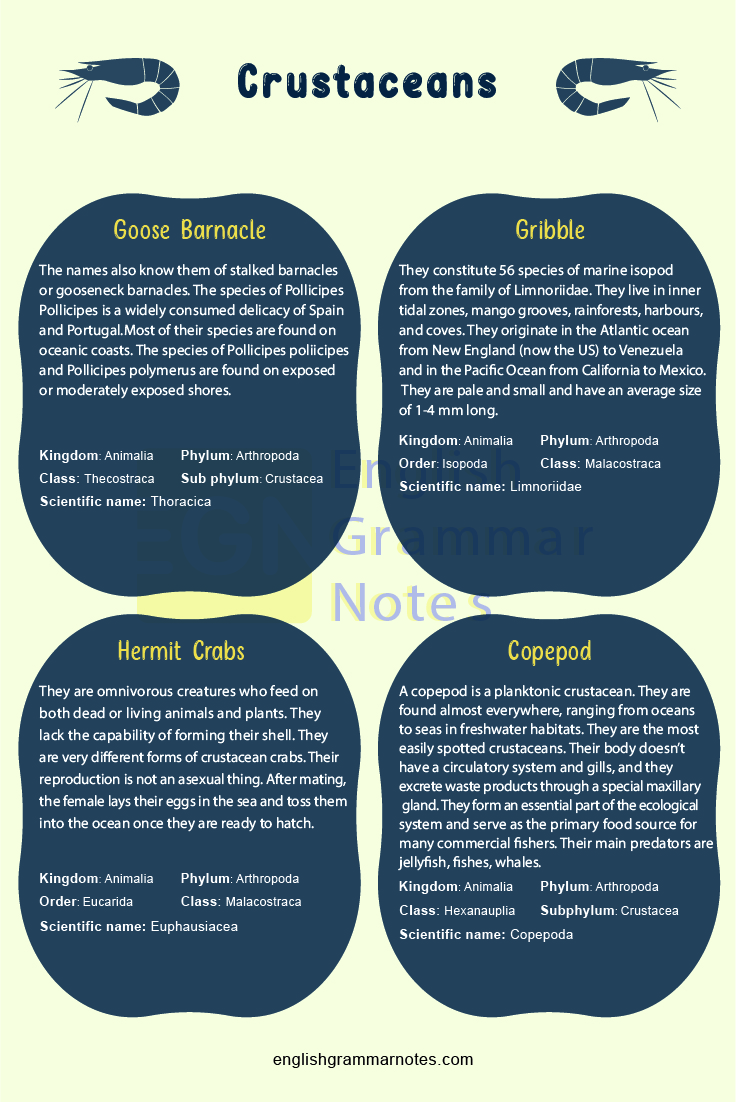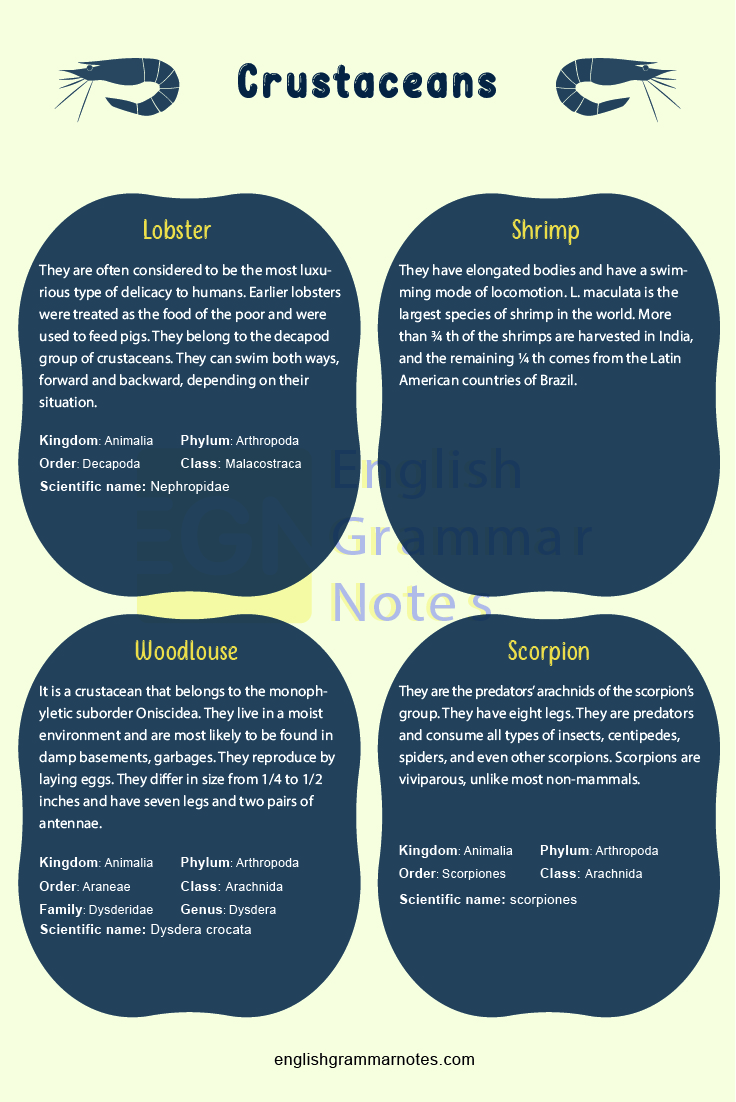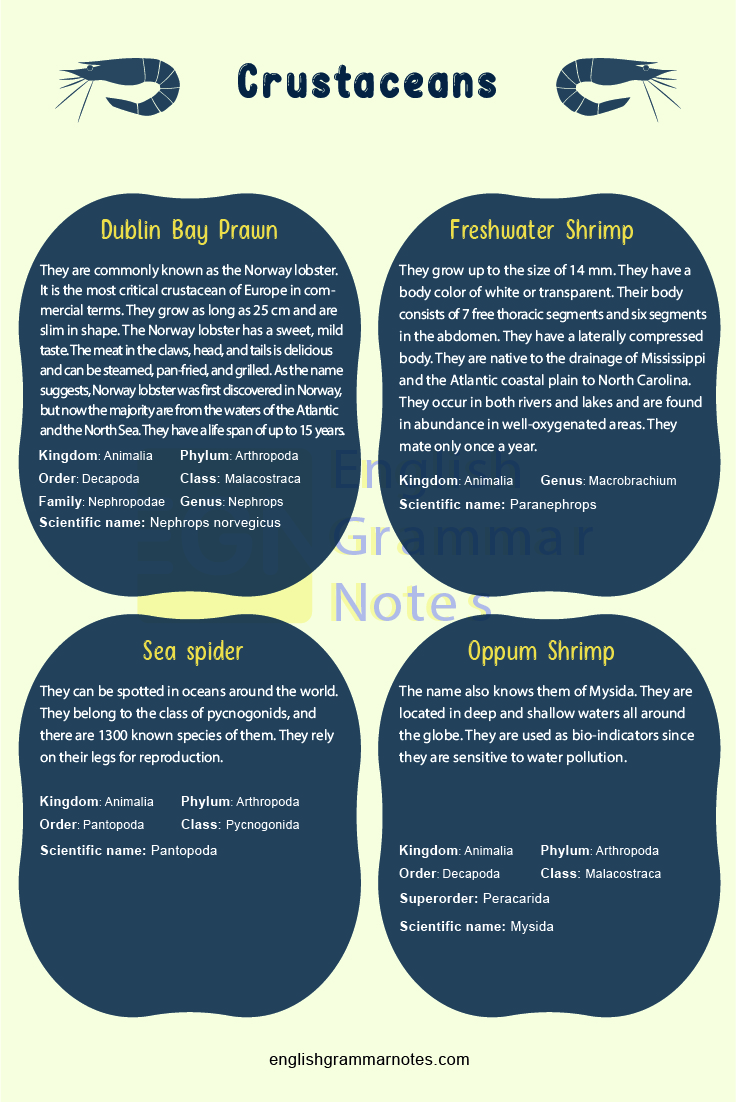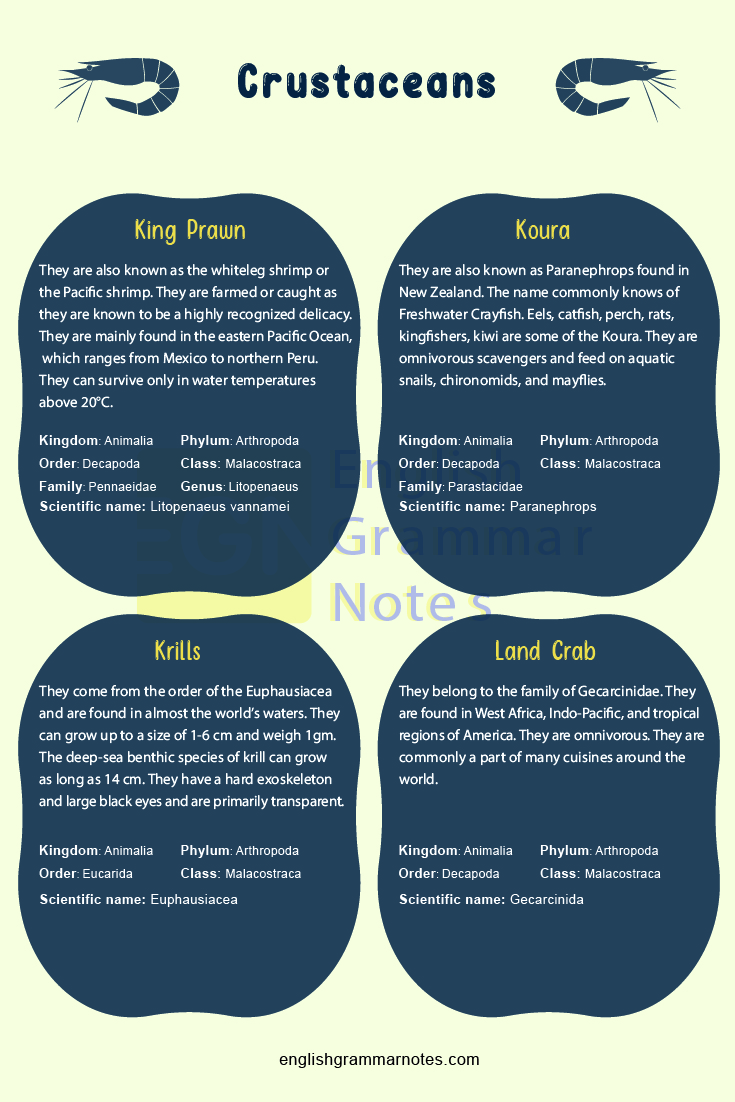Crustaceans: The crustaceans pronunciation is not a very common term for everyone, but it is something that everyone has spotted in their daily lives. Crustaceans’ habitats are vastly different from the other group of animals. They are primarily marine species numbering about 67,000, and they are significantly related to insects.
The 67,000 species vary from 0.01 mm up to a size of 3.8 m and a weight of 20 kg. Most of these species are found in aquatic bodies, but several species of crustaceans are terrestrial, parasitic, and sessile. The crustaceans form an essential part of the food chain and have extensive fossils record which dates back to the Triassic period. Carcinology is the scientific study of crustaceans, and the scientists who work in this field are known as crustaceans.
To make the study of crustaceans more interesting, the article provides a list of crustaceans and the types to which they belong.
Study the most important English Vocabulary Words identified by our experts and learn the right vocabulary to use in your day to day conversations
List of Crustaceans
Name of Crustaceans
- Barnacle
- Beach Flea
- Copepod
- Crab
- Crayfish
- Dublin Bay Prawn
- Freshwater Shrimp
- Goose Barnacle
- Gribble
- Hermit Crab
- Horseshoe Crab
- King Prawn
- Koura
- Krill
- Land Crab
- Lobster
- Oyster Crab
- Prawn
- Shrimp
- Spiny lobster
- Scorpion
- Sea spider
- Oppum shrimp
- Woodlouse
Description and Pictures on the List of Crustaceans
Barnacle
A barnacle is an arthropod within the subclass of Cirripedia. They are immobile and live in shallow waters. Some of the barnacles are parasitic, but most of them are harmless to other animals. They play a very vital role in the food chain and are also crucial in keeping the seawater clean.
They have varying sizes ranging from 0.5 to 1mm in diameter. They have six overlapping shell plates. Barnacles are edible and can be harvested and prepared.
| Kingdom | Animlia |
| Phylum | Arthropoda |
| Subphylum | crustacea |
| Class | Thecostraca |
| Scientific name | Cirripedia |
Beach Flea
The names are also known as sand crabs, sand bugs, mole crabs. They are a small subgroup of the decapod crustaceans. Given the water temperatures, they have a short life span of two or three years and can reproduce from the first year of life.
Beach fleas are primarily found on Atlantic beaches. They are utilized as a common food source for many animals, namely,
surfperch, surf scoters, and shorebirds. They live in caves on the sand where water meets the shore. These creatures can only survive in extreme temperatures.
| Kingdom | Animalia |
| Phylum | Arthropoda |
| Class | Malacostraca |
| Order | Decapoda |
| Family | Hippidae |
| Scientific name | Emerita |
Copepod
A copepod is a planktonic crustacean. They are found almost everywhere, ranging from oceans to seas in freshwater habitats.
They are the most easily spotted crustaceans. Their body doesn’t have a circulatory system and gills, and they excrete waste products through a special maxillary gland.
They form an essential part of the ecological system and serve as the primary food source for many commercial fishers. Their main predators are jellyfish, fishes, whales.
| Kingdom | Animalia |
| Phylum | Arthropoda |
| Subphylum | Crustacea |
| Class | Hexanauplia |
| Scientific name | Copepoda |

Crab
They belong to the decapod family of the crustaceans. They have a whole of ten legs and walk most comfortably in the sideways direction. Crabs form an essential part of many delicacies and are also a good provider of protein which helps in muscle building.
They are found in almost all the oceans and around salty water. Crabs consumption also prevents the body from any chronic situations.
| Kingdom | Animalia |
| Phylum | Arthropoda |
| Class | Malacostrace |
| Order | Decapopda |
| Suborder | Pleocyemata |
| Scientific name | Brachyura |
Crayfish
They are found in freshwater and are closely resembled small lobsters. Different names know them in other places such as crawdads, crawdaddies, freshwater lobsters, crawfish. They belong to the superfamilies of Astacoidea and Parastacoidea.
Crayfish are safe for human consumption only when it’s cooked. They have many health benefits the most notable of which is that it is of low calorie. A whole serving of Crayfish has only 70 calories.
| Kingdom | Animalia |
| Phylum | Arthropoda |
| Subphylum | Crustacea |
| Class | Malacostraca |
| order | Decapoda |
| Scientific name | Cambarus sp. |
Dublin Bay Prawn
They are commonly known as the Norway lobster. It is the most critical crustacean of Europe in commercial terms. They grow as long as 25 cm and are slim in shape.
The Norway lobster has a sweet, mild taste. The meat in the claws, head, and tails is delicious and can be steamed, pan-fried, and grilled.
As the name suggests, Norway lobster was first discovered in Norway, but now the majority are from the waters of the Atlantic and the North Sea. They have a life span of up to 15 years.
| Kingdom | Animalia |
| Phylum | Arthropoda |
| Class | malacostraca |
| Order | Decapopda |
| Family | Nephropodae |
| Genus | Nephrops |
| Scientific name | Nephrops norvegicus |
Freshwater Shrimp
They grow up to the size of 14 mm. They have a body color of white or transparent. Their body consists of 7 free thoracic segments and six segments in the abdomen. They have a laterally compressed body.
They are native to the drainage of Mississippi and the Atlantic coastal plain to North Carolina. They occur in both rivers and lakes and are found in abundance in well-oxygenated areas. They mate only once a year.
| Kingdom | Animalia |
| Genus | Macrobrachium |
| Scientific name | Gammarus fasciatus |
Goose Barnacle
The names also know them of stalked barnacles or gooseneck barnacles. The species of Pollicipes Pollicipes is a widely consumed delicacy of Spain and Portugal.
Most of their species are found on oceanic coasts. The species of Pollicipes poliicipes and Pollicipes polymerus are found on exposed or moderately exposed shores.
| Kingdom | Animalia |
| Phylum | Arthropoda |
| Sub phylum | Crustacea |
| Class | Thecostraca |
| Scientific name | Thoracica |
Gribble
They constitute 56 species of marine isopod from the family of Limnoriidae. They live in inner tidal zones, mango grooves, rainforests, harbours, and coves. They originate in the Atlantic ocean from New England (now the US) to Venezuela and in the Pacific Ocean from California to Mexico. They are pale and small and have an average size of 1-4 mm long.
| Kingdom | Animalia |
| Phylum | Arthropoda |
| Class | Malacostraca |
| order | Isopoda |
| Scientific name | Limnoriidae |
Hermit Crabs
They are omnivorous creatures who feed on both dead or living animals and plants. They lack the capability of forming their shell. They are very different forms of crustacean crabs.
Their reproduction is not an asexual thing. After mating, the female lays their eggs in the sea and toss them into the ocean once they are ready to hatch.
| Kingdom | Aqnimalia |
| Phylum | Arthropoda |
| Class | Malacostraca |
| Order | Decapoda |
| Scientific name | Paguroidea |
Horseshoe Crabs
They belong to the family of Limulidaeand are the only surviving member of the order of Xiphosura. They are neither considered to be true crabs nor crustaceans.
They have existed for more than 445 million years, making them older than the dinosaurs. They are mostly found in the Atlantic Ocean along the North American coastline. They are also omnivorous and feed themselves on aquatic worms, algae, carrion, etc.
| Kingdom | Animalia |
| Phylum | Arthropoda |
| Oredr | Xiphosure |
| Suborder | Xiphosuridae |
| scientific name | Limulidae |
King Prawn
They are also known as the whiteleg shrimp or the Pacific shrimp. They are farmed or caught as they are known to be a highly recognized delicacy. They are mainly found in the eastern Pacific Ocean, which ranges from Mexico to northern Peru. They can survive only in water temperatures above 20°C.
| Kingdom | Animalia |
| Phylum | Arthropoda |
| Class | Malacostraca |
| Oredr | Decapoda |
| Family | Pennaeidae |
| Genus | Litopenaeus |
| Scientific name | Litopenaeus vannamei |
Koura
They are also known as Paranephrops found in New Zealand. The name commonly knows of Freshwater Crayfish. Eels, catfish, perch, rats, kingfishers, kiwi are some of the Koura. They are omnivorous scavengers and feed on aquatic snails, chironomids, and mayflies.
| Kingdom | Animalia |
| Phylum | Arthropoda |
| Class | malacostraca |
| order | Decapopda |
| Family | Parastacidae |
| Scientific name | Paranephrops |
Krills
They come from the order of the Euphausiacea and are found in almost the world’s waters. They can grow up to a size of 1-6 cm and weigh 1gm. The deep-sea benthic species of krill can grow as long as 14 cm.
They have a hard exoskeleton and large black eyes and are primarily transparent.
| Kingdom | Animalia |
| Phylum | Aethropoda |
| Class | Malacostraca |
| Order | Eucarida |
| Scientific name | Euphausiacea |
Land Crab
They belong to the family of Gecarcinidae. They are found in West Africa, Indo-Pacific, and tropical regions of America. They are omnivorous. They are commonly a part of many cuisines around the world.
| Kingdom | Animalia |
| Phylum | Arthropoda |
| Class | Malacostraca |
| Order | Decapoda |
| Scientific name | Gecarcinida |
Lobster
They are often considered to be the most luxurious type of delicacy to humans. Earlier lobsters were treated as the food of the poor and were used to feed pigs. They belong to the decapod group of crustaceans. They can swim both ways, forward and backward, depending on their situation.
| Kingdom | Animalia |
| Phylum | Arthropopda |
| Class | Malacostraca |
| Order | Decapoda |
| Scientific name | Nephropidae |
Oyster Crab
They belong to the family Pinnotheridae. They are found in the seaboards of North America and South America.
Prawn
They are tiny aquatic crustaceans. Their body consists of ten legs, and they have an exoskeleton. Some of these prawns are edible. The term “prawn” is used mainly in the commonwealth nations, Ireland, and the United Kingdom.
There has been a lot of debate between the terms shrimp and prawn. Both are non-scientific terms. The term shrimp is more commonly used in the United States, where the term prawn is used in the United Kingdom.
Shrimp
They have elongated bodies and have a swimming mode of locomotion. L. maculata is the largest species of shrimp in the world. More than ¾ th of the shrimps are harvested in India, and the remaining ¼ th comes from the Latin American countries of Brazil.
Spiny Lobster
They are also known as rock lobsters, and they belong to the family of 60 species of achelate crustaceans. They vary in shade from white to dark red-orange. They are estimated to live up to 20-30 years.
| Kingdom | Animalia |
| Phylum | Arthropoda |
| Class | Crustacea |
| Order | Decapoda |
| Family | Latereille |
| Scientific name | Palinuridea |
Scorpion
They are the predators’ arachnids of the scorpion’s group. They have eight legs. They are predators and consume all types of insects, centipedes, spiders, and even other scorpions. Scorpions are viviparous, unlike most non-mammals.
| kingdom | Animalia |
| Phylum | Arthropoda |
| Class | Arachnida |
| Order | Scorpiones |
| Scientific name | scorpiones |

Sea spider
They can be spotted in oceans around the world. They belong to the class of pycnogonids, and there are 1300 known species of them. They rely on their legs for reproduction.
| Kingdom | Animalia |
| Phylum | Arthropoda |
| Class | Pycnogonida |
| Order | Pantopoda |
| Scientific name | Pantopoda |
Oppum Shrimp
The name also knows them of Mysida. They are located in deep and shallow waters all around the globe. They are used as bio-indicators since they are sensitive to water pollution.
| Kingdom | Animalia |
| Phylum | Arthropoda |
| Class | Malacostraca |
| Superorder | Peracarida |
| Scientific name | Mysida |

Woodlouse
It is a crustacean that belongs to the monophyletic suborder Oniscidea. They live in a moist environment and are most likely to be found in damp basements, garbages. They reproduce by laying eggs. They differ in size from 1/4 to 1/2 inches and have seven legs and two pairs of antennae.
| Kingdom | Animalia |
| Phylum | Arthropoda |
| Class | Arachnida |
| Order | Araneae |
| Family | Dysderidae |
| Genus | Dysdera |
| Scientific name | Dysdera crocata |
